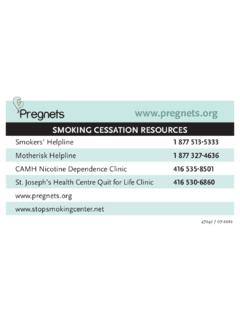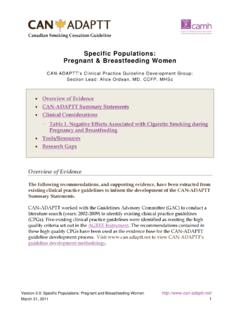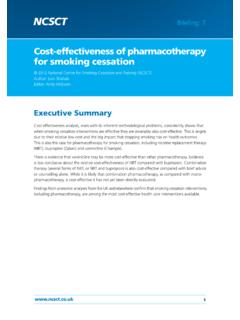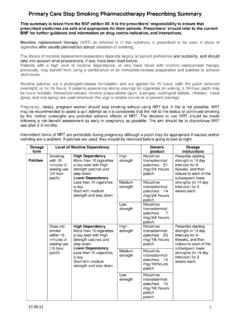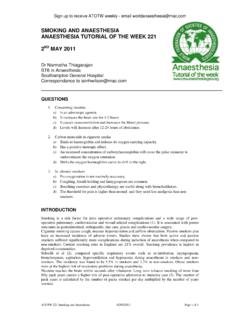Transcription of Pregnancy and Smoking: A literature review that ...
1 Pregnancy and smoking : A literature review that investigates the unique challenges that women experience during and after Pregnancy The negative health consequences of tobacco have so thoroughly permeated society that the World Health Organization (WHO) has labeled the current use of tobacco the Tobacco Epidemic .1 Among the global population of individuals who smoke, women are a subpopulation that have proven to be particularly vulnerable to the adoption and effects of tobacco use over their Presently, research indicates that the global smoking population is on its way to becoming increasingly female as the tobacco industry begins to market its products to women in developing To better understand and address the issue of smoking during Pregnancy and the postpartum period.
2 This literature review intends to examine the challenges that smoking presents to women. PREVALENCE FEMALE smoking PREVALENCE GLOBAL Among the population of global tobacco users, the proportion of them who are women has been increasing for several In 2006 the prevalence of smoking among women was 9%, which accounted for 200 million of the 1 billion global While it is believed that men s smoking rates have peaked and are now decreasing, it is projected that women s smoking will reach a prevalence of 20% globally by CANADA/ONTARIO In Canada.
3 National smoking prevalence data is collected by the Canadian Community Health Survey (CCHS) and the Canadian Tobacco Use Monitoring Survey (CTUMS), both of which are sample surveys with a cross-sectional The CCHS targets Canadians aged 12 and over and in 2009 it demonstrated that of females smoked (compared to of Canadian males).8 To further understand female smoking prevalence, data from the 2007/08 CCHS demonstrates that among females in Ontario, the highest prevalence of current smokers was 24% in the 25-29 age group.
4 Notably, the most recent data from Statistics Canada shows that Canadian females in this age group also had the highest rate of pregnancies in The CTUMS targets Canadians aged 15 and over with a focus on youth and young adults aged 15-24. Its 2009 data demonstrated that the male smoking rate had significantly decreased from 33% in 2008 to 26% in 2009. However, no such statistically significant difference was detected in the prevalence of female young adult smoking from 2008 to 2009 (22% vs. 20%, respectively).
5 PREGNANT smoking PREVALENCE Within this realm of females who smoke, there is a subpopulation of pregnant women who smoke. In the United States, combined data from 2008 and 2009 indicates that the rate of past month cigarette use was among pregnant According to the CCHS, in 2005, 10% of women in Ontario aged 20-44 who gave birth in the past five years had smoked during their most recent Pregnancy ; of these women, 5% had smoked daily while 5% had smoked More recently, CCHS data demonstrates that during the period of 2007 and 2008, 15% of pregnant women aged 15-49 years were current smokers in Ontario (as per their self-description).
6 12 In a comprehensive effort to help understand, promote and improve the health of new mothers across Canada, the Public Health Agency of Canada conducted a Maternal Experience Survey (MES). The survey was administered to mothers 15 years of age or older who gave birth to a single child in Canada during a three-month period prior to the 2006 Canadian Census of the Among a number of issues that it investigated, the MES considered women who smoked prior to, during and following Pregnancy . It found that overall of Canadian women smoked either daily or occasionally during the last trimester of their Among these women, smoked 10 or more cigarettes per day while smoked 1 to 9 cigarettes per Maternal smoking was higher among multiparous women than primiparous women ( and , respectively).
7 13 As well, women living in households that were at or below the low-income cut-off were more likely to smoke (20% vs. 7%).13 CHALLENGES WITH ESTIMATING PREVALENCE OF smoking IN Pregnancy Each of the prevalence rates presented above are based solely on self-reports given by the survey participants. None of the smoking status self-reports were biochemically validated. This is problematic because research studies have demonstrated that self-reports of smoking status underestimate smoking In pregnant women, studies have found the non-disclosure rate to range from 23-28%.
8 14-15 Therefore it is reasonable to suggest that all available global, national and provincial reports of smoking prevalence rates, particularly among pregnant women, are underestimates. It is important to consider this with respect to research, policy and practice. HEALTH MATERNAL The health consequences of smoking in women are generally considered to be more pervasive than in men for a number of reasons. The 2004 Report of the Surgeon General on women and smoking comprehensively details the health consequences of tobacco use among women and concludes that smoking is a major cause or risk factor for various cancers, heart disease and COPD, as well as a major risk factor for negative menstrual and reproductive For pregnant women who smoke, research has demonstrated that a modest increase in the risk for ectopic Pregnancy and spontaneous abortion As well.
9 smoking during Pregnancy is associated with increased risks of various complications including abruptio placentae, placenta previa, and premature rupture of A modest increase in risk for preterm delivery is also associated with smoking during FETAL When a woman who is pregnant smokes, the negative effects of smoking pose health risks to both her and her Nicotine is a chemical that is known to cross the In fact, the amniotic fluid and fetal circulation demonstrate higher levels of nicotine than found in the mother s own plasma and Research indicates that nicotine decreases the availability of oxygen to the fetus, increases fetal heart rate and reduces breathing movement of the INFANT The 2006 Report of the Surgeon General on the health consequences of involuntary exposure to tobacco smoke concluded that there was sufficient evidence (Level 1)
10 To infer a causal relationship between exposure of an infant to second-hand smoke and Sudden Infant Death Syndrome (SIDS) as well as maternal exposure to second-hand smoke and a reduction in birth The report qualified the evidence between maternal second-hand smoke exposure and pre-term delivery or childhood cancer as suggestive (Level 2).22 Additionally, children exposed to second-hand smoke are at an increased risk of acute respiratory infections, ear problems, and more severe Inadequate evidence (Level 3) prevented the report from drawing a causal relationship of second-hand smoke exposure with.
